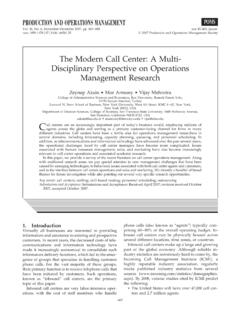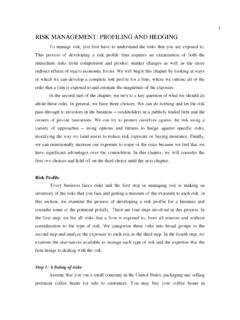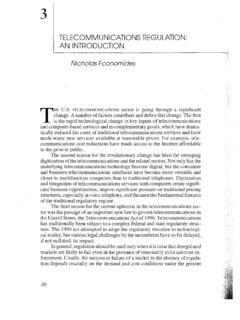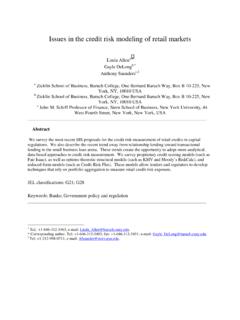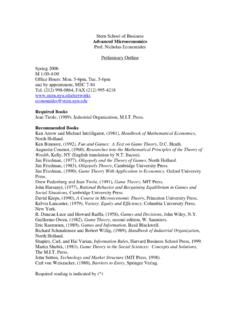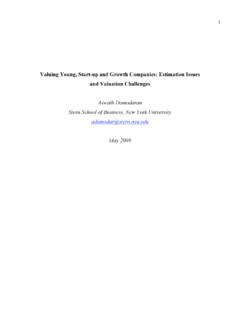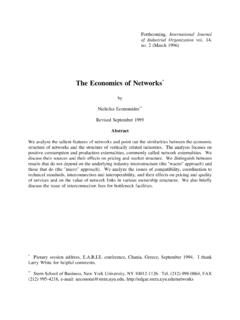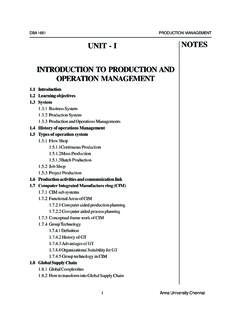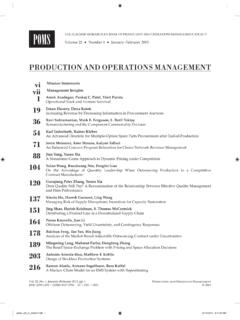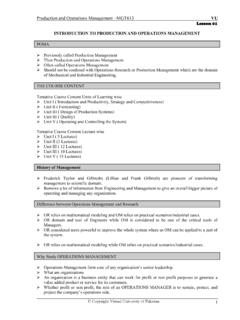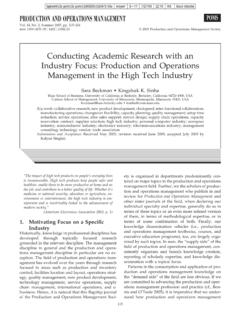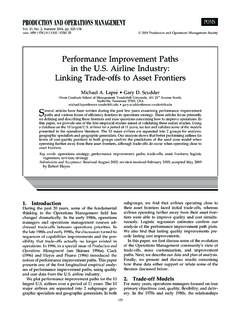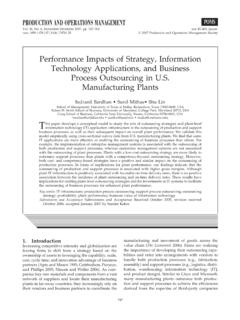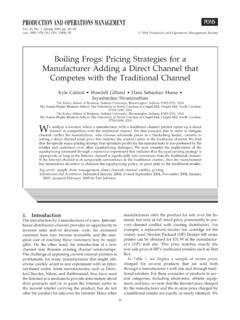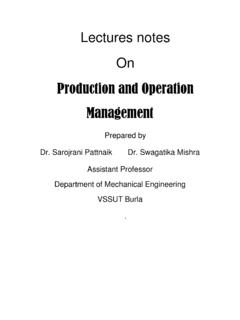Transcription of PRODUCTION AND OPERATIONS MANAGEMENT …
1 OPERATIONS in Financial Services An OverviewEmmanuel D. (Manos) HatzakisGoldman Sachs Asset MANAGEMENT , Goldman, Sachs & Co., New York, New York 10282-2198, USA, K. NairDepartment of OPERATIONS and Information MANAGEMENT , School of Business, University of Connecticut, Storrs, Connecticut 06269-1041, L. PinedoDepartment of Information, OPERATIONS and MANAGEMENT Science, Leonard N. Stern School of Business, New York University,New York, New York 10012-1106, USA, provide an overview of the state of the art in research on OPERATIONS in financial services. We start by highlighting anumber of specific operational features that differentiate financial services from other service industries, and discusshow these features affect the modeling of financial services. We then consider in more detail the various different researchareas in financial services, namely systems design, performance analysis and productivity, forecasting, inventory and cashmanagement, waiting line analysis for capacity planning, personnel scheduling, operational risk MANAGEMENT , and pricingand revenue MANAGEMENT .
2 In the last section, we describe the most promising research directions for the near words:financial services; banking; asset MANAGEMENT ; processes; operationsHistory: Received: November 2009; Accepted: July 2010 by Kalyan Singhal, after 2 IntroductionOver the past two decades, research in service oper-ations has gained a significant amount of issues ofProduction and OPERATIONS Managementhave focused on services in general (Apte et al. 2008),and various researchers have presented unified theories(Sampson and Froehle 2006), research agendas (Roth andMenor 2003), literature surveys (Smith et al. 2007),strategy ideas (Voss et al. 2008), and have discussedthe merits of studying service science as a new discipline(Spohrer and Maglio 2008). A few books and a specialissue ofManagement Sciencehave focused on the oper-ational issues in financial services in particular (seeHarker and Zenios 1999, 2000, Melnick et al.)
3 2000).However, financial services have still been given scantattention in much of the literature relative to otherservice industries such as transportation, health care,entertainment, and hospitality. The dilution of focus, byconcentrating on more general distinguishing featuresdoes not do justice to financial services where some ofthese characteristics are notcentral. (The more generalfeatures that are typically being considered includeintangibility, heterogeneity, contemporaneous produc-tion and consumption, perishability of capacity, waitinglines (rather than inventories), and customer participa-tion in the service delivery.)In this overview, we mean byfinancial servicesprimarily firms in retail banking, commercial lending,insurance (other than health), credit cards, mortgagebanking, brokerage, investment advisory, and assetmanagement (mutual funds, hedge funds, etc.
4 Importance of Financial ServicesFinancial services firms are an important part of theservice sector in an economy that has been growingrapidly over the past few decades. These firms pri-marily deal with originating or facilitating financialtransactions. The transactions include creation, liqui-dation, transfer of ownership, and servicing ormanagement of financial assets; they could involveraising funds by taking deposits or issuing securities,making loans, keeping assets in custody or trust, ormanaging them to generate return, pooling of risk byunderwriting insurance and annuities, or providingspecialized services to facilitate these a large category that encompasses firmsas diverse as retail establishments, transportationfirms, educational institutions, consulting, informa-tion, legal, taxation, and other professional, real estate,and healthcare.
5 Even within financial services, there isa wide variety of firms which are characterized byunique PRODUCTION processes and specialized processes and skills required for banking arequite distinct from solicitations for credit cards, ac-quisitions of new insurance accounts, or the handlingof equity dividends and proxy voting, for AND OPERATIONS MANAGEMENTVol. 19, No. 6, November December 2010, pp. 633 664 ISSN1059-1478|EISSN1937-5956|10|1906| PRODUCTION and OPERATIONS MANAGEMENT SocietyEven though services account for about 84% of thetotal employment in the economy, only about 4% ofthis workforce is employed in financial services. Thismight come as a surprise to some because financialservices transactions in one form or another are soubiquitous in our lives. Not surprisingly, however, thenumber of financial services firms is about 7% of thetotal non-farm firms and contributes about 13% of to-tal non-farm sales.
6 Only wholesale trade has a similaremployment and number of firms with a larger con-tribution to 1 provides employment information for thesub-codes within financial services. As can be seen,retail banks, insurance companies, and insurance bro-kers together employ about two-thirds of the financialservices workforce. A cursory look at the table gives asense of the diversity of the services sector. Clearlyoperations MANAGEMENT problems and approachesused to solve them have to be customized for partic-ular types of services we already know that whatworks for manufacturing may not work for services,but by looking at Table 1 we can also realize that whatworks for retail trade or recreational services may notwork for financial services. A quick glance s job openings for OPERATIONS managersin financial service firms shows a wide variety of ti-tles, responsibilities, and products related to suchjobs.
7 This is shown in Table 2, and gives a sense of thewide swath of topics that could be covered in aca-demic research on financial services OPERATIONS . Asfinancial services are such an important segment ofthe services economy, we wish to explore whetheroperations in financial services are indeed unique, orshare several characteristics with services in is the motivation for this special Distinctive Characteristics of OPERATIONS inFinancial ServicesThere are several unique operational characteristicsthat are specific to the financial services industry andthat have not been given sufficient attention in thegeneral treatment of services in the extant list below a number of these unique operationalcharacteristics and elaborate on them in what follows: Fungible products with an extensive use oftechnology High volumes and heterogeneity of clients Repeated service encounters Long-term contractual relationships betweencustomers and firms Customers sense of well-being closely inter-twined with services Use of intermediaries Convergence of OPERATIONS , finance, and Fungible Products with an Extensive Useof obvious difference betweenoperations in financial services and OPERATIONS inmanufacturing and in other service industries is thatthe widgets in financial services are money, or relatedfinancial instruments.
8 As there is a declining use of thephysical vestiges of money such as coins, currency,Table 1 Employment within Financial ServicesNAICS codeTitle within financial servicesTotal employeesNumber%5211 Monetary authorities-central bank(Federal Reserve banks, etc.)21, credit intermediation(banks, credit unions, etc.)1,816, credit intermediation(credit cards, mortgage lending, etc.)659, related to credit intermediation(brokers for lending)294, and commodity contractsintermediation and brokerage516, and commodity exchanges8, financial investment activities(mutual funds, etc.)344, carriers1,258, , brokerages, and otherinsurance-related activities907, and employee benefit funds47, investment pools and funds41, ,916,470 : Bureau of Labor Statistics, , May 2 A sample of Financial Service OPERATIONS Job Titles, Responsi-bilities, and ProductsTitlesProductsVice President, OPERATIONS , Opera-tions Manager, Financial OperationsSupervisor, Foreclosure and Bank-ruptcy OPERATIONS Manager, RiskOperations Team Manager, TeamManager Ops Control-Fixed Income,National Director OPERATIONS , HedgeFund OPERATIONS Specialist, VP/Director Of OperationsPremiums, Claims, Refunds, Cashflow and treasury MANAGEMENT ,Customer statements, Loan servi-cing and support, Tradeconfirmations, Reconciliations, Taxreporting, Security settlements,MortgagesNature of work/responsibilityBrokerage OPERATIONS , Improve customer service, resolves customer issues,Review security pricing, Vendor support, Authorize net settlement, Hand-off ofdata, ensure data integrity, Verifying transactions, Tracking missing transactions.
9 Leverage technology, Maintain ops controls, update policies, procedures, Back-office support, Understand regulations, Ensure compliance, Attain profit andrevenue benchmarks, Reduce risk, Improve quality, Six sigma, Operationalprocessing efficiency, Problem solving, Ensure best practices, Streamlineactivities, Manage key expenses, Work MANAGEMENT tools, Monitors work flow, PRODUCTION /testingSource: jobs listings during the week of March 8, , Nair, and Pinedo: OPERATIONS in Financial Services An Overview634 PRODUCTION and OPERATIONS MANAGEMENT 19(6), pp. 633 664,r2010 PRODUCTION and OPERATIONS MANAGEMENT Societybond, or stock certificates, much of the transactions arein the form of bits and bytes. Thus inventory is fungibleand can be transported, broken up, and reconstituted(facilitating securitization, ) in malleable ways thatare simply not possible in manufacturing or in otherservice industries (see, , the recharacterization ofbank reserves in Nair and Anderson 2008).
10 The increased use of online transactions (in broker-ages, credit card payments, retail banking, and retire-ment accounts, ) are forcing fundamental changes inthe way OPERATIONS managers think about capacity is-sues (for statement mailing and remittance processing,or for transfer of ownership in securities, ). The factthat adoption of online transactions is still growing andhas not yet matured and leveled off makes capacityplanning a big challenge. Yet we are aware of very littleresearch that would help managers deal with this High Volumes and Heterogeneity of services are characterized by very highvolumes of customers and transactions. Furthermore,customers are not all alike. In many firms, a smallfraction of the customers generate most of the profits,giving the firms an incentive to view them differentlyand provide differential treatment, given the firms limited resources.
